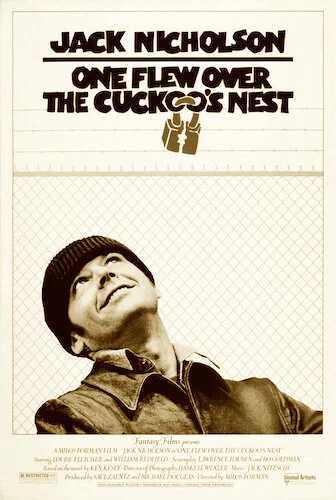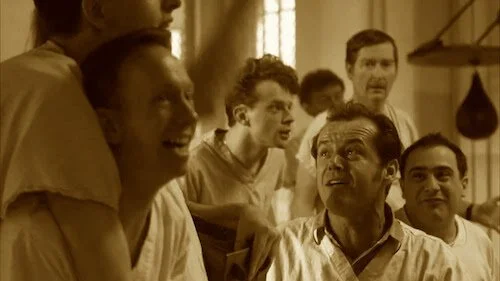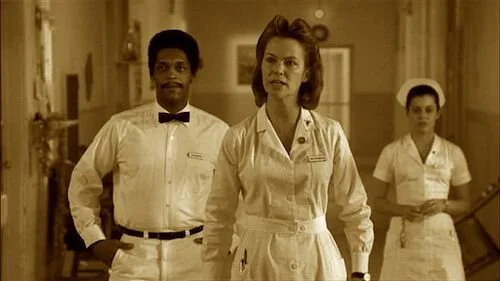One Flew Over the Cuckoo's Nest
This review is a part of the Best Picture Project: a review of every single Academy Award winner for the Best Picture category. One Flew Over the Cuckoo’s Nest is the forty eighth Best Picture winner at the 1975 Academy Awards.
The three films to pull off the big five wins (Best Picture, Director, Actor, Actress, and Screenplay [of either variety]) at the Academy Awards almost feel like the bookmarks of each era of the ceremony. It Happened One Night was early, and made a statement that the Academy was figuring out which golden age works were destined to remain classics. The Silence of the Lambs was an indication that the edgiest mainstream films can somehow push through Oscar bait, as long as they are well made. One Flew Over the Cuckoo’s Nest is in the middle of both other winners. It sealed the popular films of that era that didn’t need to be completely rebellious to make a stink. Did it have room to grow because of the abolishment of the Hayes Code? Yes. Did it go above and beyond to alienate viewers? No.
Based on the established Ken Kesey novel, Miloš Forman’s cinematic vision makes some clever changes that may not act as improvements to the source material, but make better sense on the big screen. The first is changing the point of view from the novel. In the film, it feels as though we are viewing the inhabitants of a mental institution ourselves; it serves up for a meatier surprise in the third act of the film (one I will remain tight lipped about if you haven’t seen the film yet). It also removes any biases attached to the lead character Randle McMurphy; a warranted attribution to this role, considering the heinous reasons as to why he is in the institution in the first place. I never felt great about this character, but I appreciated Forman’s removal of us having to approve this person. We can acknowledge his efforts to better the living environment of his fellow patients without dismissing his past actions.
Part of Cuckoo’s Nest analysis on mental health is spent on the patients…
We know why the film is beloved now. The strong cast, the deep writing, and the universal appeal have rendered Cuckoo’s Nest a cinematic mainstay. Excluding these facets, what could have made Cuckoo’s Nest a heavy hitter back in the mid ‘70s? Well, the main reason I would assume is because of its reasonably level-headed approach to mental health awareness for its time. We can’t forget that this film was based on a book which would have had this same discussion years before. Yet, try to imagine which mainstream films before Cuckoo’s Nest were trying to represent mental illnesses in a way that wasn’t 1) a plot trope, 2) a reason for villainy or weakness, or 3) a joke and/or gimmick. On a mainstream level. There weren’t many. Cuckoo’s Nest made those suffering with mental disabilities the main story; living, breathing people, if you will. Even the actual narrative was a debatable discussion: was McMurphy helping his fellow patients more than head Nurse Ratched? Was Ratched misunderstood throughout the course of the film, or was she actually control hungry?
Cuckoo’s Nest likes to indulge in its side-missions a bit, but it always knows how to come back to the main story, and make all of these excursions meaningful. Each sidestep becomes a lesson that McMurphy and Ratched disagree on. Each instance is an extra scenario we have to discuss. If X was okay, is Y also okay? By the extreme conclusion, where no one really wins, you’ll be wondering if that explosion could have been prevented. Sometimes, rebelling against authority is not the right answer; then again, neither is forgoing your freedom to those that command it. There is no straight forward answer in Cuckoo’s Nest. Maybe that’s why it’s still so cherished.
… and the staff that act as authoritative figures.
Person vs society. Patient vs authority. Voice vs voice. One Flew Over the Cuckoo’s Nest is still a well presented means of providing a hypothesis, and not shoving down one loaded opinion down your throat. With all of the patients, and all of the staff members, we get many perspectives tossed into a blender. Of course, McMurphy and Ratched speak the loudest on either side, but the magic comes from being able to know what other participants have been wanting to say for ages. There isn’t much negativity that comes from this Hollywood staple. It’s a crowd pleaser that never forgoes its complexities to appeal to wider crowds. It’s no wonder why it’s still as popular now as it ever was.
Andreas Babiolakis has a Masters degree in Film and Photography Preservation and Collections management from Ryerson University, as well as a Bachelors degree in Cinema Studies from York University. His favourite times of year are the Criterion Collection flash sales and the annual Toronto International Film Festival.







